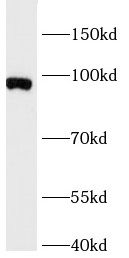Products
FOXO3 antibody
| Size | Price |
|---|---|
| 100ug | Inquiry |
- SPECIFICATIONS
- FIGURES
- CONDITIONS
- FAQS
- Product Name
- FOXO3 antibody
- Catalogue No.
- FNab10245
- Size
- 100μg
- Form
- liquid
- Purification
- Immunogen affinity purified
- Purity
- ≥95% as determined by SDS-PAGE
- Clonality
- polyclonal
- Isotype
- IgG
- Storage
- PBS with 0.02% sodium azide and 50% glycerol pH 7.3, -20℃ for 12 months (Avoid repeated freeze / thaw cycles.)
- Immunogen
- forkhead box O3
- Alternative Names
- Forkhead box protein O3|AF6q21 protein|Forkhead in rhabdomyosarcoma-like 1|FOXO3|FKHRL1|FOXO3A antibody
- UniProt ID
- O43524
- Observed MW
- 90 kDa
- Tested Applications
- ELISA, WB, IHC
- Recommended dilution
- WB: 1:500 - 1:2000; IHC: 1:50 - 1:200
 HEK-293 cells were subjected to SDS PAGE followed by western blot with FNab10245(FOXO3A antibody) at dilution of 1:1000
HEK-293 cells were subjected to SDS PAGE followed by western blot with FNab10245(FOXO3A antibody) at dilution of 1:1000
 Immunohistochemistry of paraffin-embedded human breast cancer using FNab10245(FOXO3A antibody) at dilution of 1:50
Immunohistochemistry of paraffin-embedded human breast cancer using FNab10245(FOXO3A antibody) at dilution of 1:50
- Background
- Forkhead box O-class (FOXO) transcription factors are mammalian homologue of DAF-16, a known lifespan regulator of Caenorhabditis elegans. FOXO transcription factors, such as FOXO1, FOXO3a, and FOXO4, have been linked to the regulation of cell cycle, apoptosis, DNA repair, oxidative stress, and metabolism. FOXO proteins are proposed to be dual regulated by Akt-mediated phosphorylation and Skp2-mediated ubiquitination, which are usually initiated by growth factors and cytokines. FOXO proteins are also activated by stress, which induces gene expression that contributes to cell cycle arrest, implicating FOXO proteins as tumor suppressors. Specifically, FOXO3a (FKHR-L1) is a transcriptional activator for apoptosis in the absence of survival factors, such as in neural cell death triggered by oxidative stress. In the presence of survival factors like IGF-1, AKT1/PKB phosphorylates on Thr-32 and Ser-253. FOXO3a is inactivated when phosphorylated by AKT1 on Thr-32 and Ser-253.
How many times can antibodies be recycled?
First, usually it's not suggested to recycle antibodies. After use, buffer system of antibodies has changed. The storage condition of recycled antibodies for different customers also varies. Thus, the performance efficiency of recycled antibodies can’t be guaranteed. Besides, FineTest ever conducted the antibody recycling assay. Assay results show recycling times of different antibodies also varies. Usually, higher antibody titer allows more repeated use. Customers can determine based on experimental requirements.
Notes: After incubation, we recycle rest antibodies to centrifuge tube and store at 4℃. High titer antibodies can be stored for a minimum of one week. Reuse about three times.
What are components of FineTest antibody buffer?
Components of FineTest antibody buffer are usually PBS with proclin300 or sodium azide, BSA, 50% glycerol. Common preservative is proclin300 or sodium azide, which is widely applied in the lab and industry.
How about the storage temperature and duration of FineTest antibodies?
Most antibodies are stored at -20℃. Directly-labeled flow cytometry antibodies should be stored at 2 - 8℃. The shelf life is one year. If after sales issues for purchased antibodies appear, return or replacement is available. Usually, antibodies can be still used after the one-year warranty. We can offer technical support services.
Is dilution required for FineTest antibodies? What’s the dilute solution?
Directly-labeled flow cytometry antibodies are ready-to-use without dilution. Other antibodies are usually concentrated. Follow the dilution ratio suggested in the manual. Dilute solution for different experiments also varies. Common antibody dilution buffers are acceptable(e.g. PBST, TBST, antibody blocking buffer).
How to retrieve antibodies for immunohistochemistry?
Common retrieval buffers: Tris-EDTA Buffer(pH 9.0); Citrate Buffer(pH 6.0)
Heat induced antibody retrieval:
Method 1: Water-bath heating: Put the beaker with retrieval buffer and slide in the boiling water bath. Keep the boiling state for 15min. Naturally cool to room temperature;
Method 2: Microwave retrieval: Put the beaker with retrieval buffer and slide in the microwave oven. Heat at high power for 5min, Switch OFF for 3min, Heat at medium power for 5min. Naturally cool to room temperature.
How to choose secondary antibodies?
(1) Secondary antibodies react with primary antibodies. Thus, secondary antibodies should be against host species of primary antibodies. E.g. If the primary antibody is derived from rabbit, the relevant secondary antibody should be against rabbit. E.g. goat anti rabbit or donkey anti rabbit.
(2) Choose secondary antibody conjugates according to the experimental type, e.g. ELISA, WB, IHC etc. Common enzyme conjugated secondary antibodies are labelled by HRP, AP etc. Fluorescin or dye labelled secondary antibodies are applied in immunofluorescence and flow cytometry(e.g. FITC, Cy3).
